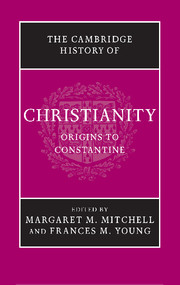Book contents
- Frontmatter
- Prelude: Jesus Christ, foundation of Christianity
- Part I The Political, Social and Religious Setting
- Part II The Jesus Movements
- 4 Jewish Christianity
- 5 Gentile Christianity
- 6 Johannine Christianity
- 7 Social and ecclesial life of the earliest Christians
- Part III Community Traditions and Self-Definition
- Part IV Regional Varieties of Christianity in the First Three Centuries
- Part V The Shaping of Christian Theology
- Part VI ‘Aliens’ become Citizens: towards Imperial Patronage
- Conclusion: retrospect and prospect
- Bibliographies
- Index
- Map 1. The Roman Empire in the time of Marcus Aurelius
- References
7 - Social and ecclesial life of the earliest Christians
from Part II - The Jesus Movements
Published online by Cambridge University Press: 28 March 2008
- Frontmatter
- Prelude: Jesus Christ, foundation of Christianity
- Part I The Political, Social and Religious Setting
- Part II The Jesus Movements
- 4 Jewish Christianity
- 5 Gentile Christianity
- 6 Johannine Christianity
- 7 Social and ecclesial life of the earliest Christians
- Part III Community Traditions and Self-Definition
- Part IV Regional Varieties of Christianity in the First Three Centuries
- Part V The Shaping of Christian Theology
- Part VI ‘Aliens’ become Citizens: towards Imperial Patronage
- Conclusion: retrospect and prospect
- Bibliographies
- Index
- Map 1. The Roman Empire in the time of Marcus Aurelius
- References
Summary
The movement that began with Jesus of Nazareth and would eventually become the Christian church in its manifold varieties developed with astonishing rapidity and exhibited diverse forms from its earliest years. Most of those early developments remain invisible to us, and scholarly attempts to plot their outline must be viewed with scepticism, but roughly we may say, with a modern sociologist, that the movement began as a Jewish sect and was soon transformed into a Graeco-Roman cult. The evolution was not unilinear. Some experiments, probably more than we can know, failed; others were suppressed by rival groups. We can piece together only fragmentary pictures from several aspects of that process – the social forms of association from the Galilean beginnings to the post-Easter community in Jerusalem and the house congregations in the cities of the Roman empire, the social location of typical converts, forms of worship and ritual and other dimensions of an emerging Christian subculture.
Community organisation
Perhaps the most profound innovation that the followers of Jesus introduced into the ancient Mediterranean world was a new form of religious community. There is much truth in the assertion by Adolf von Harnack, in his classic study of ‘the mission and expansion of Christianity’, that by the year 300 ce it was ‘this church itself … through its mere existence’ that had replaced the activity of ‘missionaries’ in apostolic times, and that it was able to do so by indigenising its radical and revolutionary claims into forms that seemed ‘familiar, wished-for, and natural’.
Keywords
- Type
- Chapter
- Information
- The Cambridge History of Christianity , pp. 144 - 174Publisher: Cambridge University PressPrint publication year: 2006
References
- 3
- Cited by

